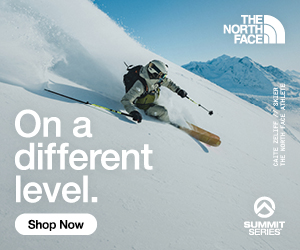Backcountry ski adventurers, Shaun Mittwollen and Ben Armstrong, have done it again and conquered another first descent in Tasmania.
Together with fellow adventure skier, Jacob Fisher and photographer and climber, Daygin Prescott, the squad of four hit up the famed Cradle Mountain on an expedition that could only happen when the snow gods aligned. A rare event in alpine Tasmania.
We spoke with The North Face Ambassador, Shaun, about what it took to make it happen.
Why this descent on Cradle Mountain?

The South Couloir on Cradle Mountain is, in my opinion, in the top three ski lines in Australia for its aesthetics and quality.
After first uncovering and skiing the South Couloir back in 2020, I wondered if it was possible to link a descent into the South Couloir from the summit of Cradle, making a more complete descent of the mountain. Whilst I’ve made a lot of ski descents on the east and west faces I felt combining a route that encompasses the best of the mountain, and indeed skiing too, would be very rewarding.
I knew the South Face is precipitous and very rocky and from a distance it looks like a shear cliff. But detailed observations reveal a series of fingery chutes of unknown width that look like they may occasionally fill with snow.
But it was extremely hard to determine if these chutes were continuous and how steep they were, given there was no vantage point to look directly at the face. In the end I wound up using images sleuthed from scenic flights and ultralight flights online.
In 2022 I down climbed one of the chutes in poor snow and felt it was worth a look during a year with decent coverage.
This particular descent has it all. Incredibly exposed steep skiing on the south face, easy skiing from the beautiful summit plateau, steep downclimbs, potential ropework and of course the stunning South Couloir.
I prefer to not map out specific locations and access publicly, as it spoils the adventure for others. Finding locations via your own research is part of the fun.
But I will say the route took us a single day, rare for Tasmanian backcountry skiing. We covered 18km with 1300m of vertical.
Proficient use of ice axes and crampons was necessary often at times on awkward snow covered boulders.
If you’re going out on an adventure I think it’s very important to be able to assess your own limitations and experience and take time to build up the necessary experience to achieve your goals.
The reality is on an adventure making a wrong decision or mistake can easily kill you and that is your responsibility alone as soon as you set foot on that adventure.
Unfortunately we now live in quite an age of instant gratification where overly enthusiastic adventurers can massively overstep their experience and find themselves in trouble.
Make smart decisions and take a conservative approach. Know when to back away.
I think it’s also especially important to be respectful of the environment in this sensitive alpine area. In the alpine the ecosystem already has to deal with the hostility of the weather, a very short growing season and so any small pressure can have a large impact.
What did you think would be the biggest challenge?

The main issue would be snowfalls, which have become incredibly fickle in recent years in Tasmania due to our impact on the climate. Until late August/early September there was essentially no skiable snow outside snowmaking areas at Ben Lomond. Even on the highest summits.
But if there’s one thing that would encourage snowfall that would be booking other plans. Of course as soon as my plans made me unavailable an amazing forecast perked up on the models. Two systems would impact Tasmania delivering 50-100cm of snow over the space of about 10 days. It was a proper quality system. Luckily, I was back home the day the weather broke after the storm and we didn’t miss out.
My main concern on the day was ice. The south face is exposed to constant winds and I was concerned the face would be scoured back to unedgeable ice. With slope angles over 50 degrees this would mean it would be unskiable, at least for my own abilities.
But on the day we encountered very little ice. The snow conditions were really quite incredible. Probably up there as the best snow I’ve skied in Tassie.
When we first edged into the south face, a nice field of soft snow quickly rolled out of view laced with rocks. The skis I was riding had a compressed core and busted sidewall after hitting similar rocks on Barn Bluff a few weeks prior (taking expressions of interest for a ski sponsor…). So I thought, ahh here we go again.
Nevertheless I skied towards the roll to have a proper look. It was easy to get between the rocks, and below that was another steeper snow spine built up behind a rock buttress. From there the slope rolled over further through fingery little chutes about a metre wide. This section was unskiable but an easy and fun downclimb for about 10m. Below that another steep snow gully.
With experience skiing in steep terrain I’ve become accustomed to gradients over 45 degrees and keeping a cool head above exposure. I think it was very fortunate the snow was so conducive to steep skiing.
Soft surface conditions dramatically reduced sliding hazard which I feel is the scariest aspect of steep skiing. And with this removed it was much easier to relax into the line.
Much of the line would have been between 45-50 degrees with the downclimb grading to possibly around 55.
Why has this descent not been done before?
There are very few people backcountry skiing in Tasmania and the conditions are very fickle. It’s not the kind of place you can just fly down to and expect to score even if you see a big storm.
You have to put in the time and effort to understand the peculiarities of access along with pinpointing micro influences on the weather and snow accumulations. Even getting to the trailhead after a big storm can be a huge hassle with many hurdles to overcome.
All this is part of the learning experience of an adventure. The main reason this line itself hasn’t been skied is mainly because it just isn’t visible from any common vantage points. Even standing on the summit you’d have no idea it was there.
It’s also an incredibly steep and imposing line. Like many of the couloirs in Tassie the gradient is around 50 degrees, however with the added risk of exposure, and cliffs in and below the line.
Really we couldn’t have scored better conditions. To match the snow the weather was absolutely splendid. The temps topped out at +4c on the summit with clear skies and no wind. The view to the south was incredible.
The entire northern overland was more heavily loaded than I’ve ever seen and we could see Frenchman’s Cap in the distance also had great coverage.
Tasmania, the quiet adventure achiever

One of The North Face’s main mottos is to never stop exploring. This is something that rings true for myself. There is adventure everywhere big and small and often in overlooked places. It can be so easily to be distracted by the bigger and bolder objectives of global summits and in doing so we neglect our own backyard.
So often people scoff at Tasmanian skiing but in my opinion they are writing it off without actually trying. In Tasmania’s case it’s not entirely about the skiing but more so about the adventure. And sure it’s fickle, but when it’s on, the reward is so much greater because of this novelty factor.
*Watch this space for Shaun Mittwollen and Cameron ‘Woody’ Wood’s film project on an overlooked area of Japan, supported by The North Face.
*article feature image by Daygin Prescott for The North Face






































